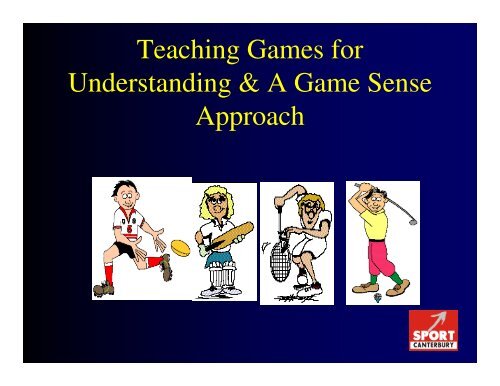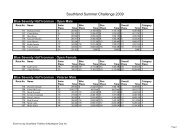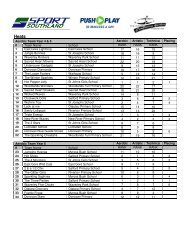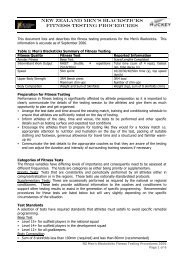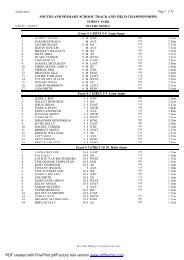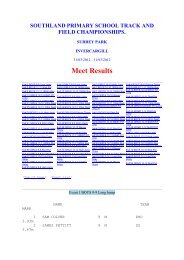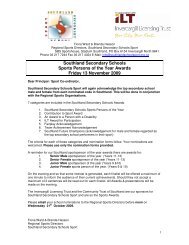Teaching Games for Understanding & A Game ... - Sport Southland
Teaching Games for Understanding & A Game ... - Sport Southland
Teaching Games for Understanding & A Game ... - Sport Southland
You also want an ePaper? Increase the reach of your titles
YUMPU automatically turns print PDFs into web optimized ePapers that Google loves.
<strong>Teaching</strong> <strong><strong>Game</strong>s</strong> <strong>for</strong><br />
<strong>Understanding</strong> & A <strong>Game</strong> Sense<br />
Approach
Concerns of traditional approach<br />
Players are often drilled to death<br />
Often assumption made that skills will transfer to<br />
a game<br />
Traditional to teach skills separately and then play<br />
the game<br />
Tedious, regimented, repetitive<br />
No emphasis on decision making or application of<br />
skills in game contexts
Emphasis on:<br />
1 What do young people want from a sports<br />
experience?<br />
2 Under what circumstances do young<br />
people best learn?<br />
3 What competencies do players need to<br />
play effectively and have fun.<br />
It is possible to become a better player almost immediately!
Good read!<br />
<strong>Teaching</strong> games <strong>for</strong> understanding (TGFU)<br />
– Denis Slade (Massey)<br />
Play Practice (Alan Launder/Bob Bigelow)<br />
“Let the children play” – Bob Bigelow<br />
<strong>Game</strong> sense (Australian model)
Learning<br />
• <strong><strong>Game</strong>s</strong> sense is understanding in action<br />
• Young players begin acquiring games sense<br />
as they apply the rules and principles of<br />
play.<br />
• Coaches must teach <strong>for</strong> understanding.<br />
• Skills continue to develop through attempts<br />
to fulfill the tactics. (eg long / short passes in football)
Rationale behind TGFU<br />
Aims to improve game per<strong>for</strong>mance<br />
Directs learner toward the ‘what’ ‘when’ ‘who’<br />
‘where’ and the ‘how’<br />
Highlights the need <strong>for</strong> thinking and moving – both<br />
on the ball and off the ball<br />
Each variety of sport: invasion, net etc. has similar<br />
tactics<br />
Skill = techniques + tactics
Technique Based<br />
Warm Up<br />
Technique drills<br />
(skill learning)<br />
<strong>Game</strong><br />
Warm down<br />
Warm up<br />
<strong>Game</strong><br />
TGFU<br />
Questions and challenges<br />
Back to game (or<br />
technique development)<br />
Further questions and<br />
challenges<br />
Progression of game<br />
Repeat above cycle<br />
Warm Down
Workshops<br />
• Design a practice to develop one skill using<br />
a game style approach.<br />
• Design a progression of practice games that<br />
can teach and develop a skill and its<br />
decision making components.
Tag <strong><strong>Game</strong>s</strong>;<br />
Target <strong><strong>Game</strong>s</strong>;<br />
Net and Wall <strong><strong>Game</strong>s</strong>;<br />
Invasion <strong><strong>Game</strong>s</strong>;<br />
Fielding <strong><strong>Game</strong>s</strong>.<br />
<strong>Game</strong> Categories<br />
Acknowledgement: Thorpe, Bunker and Almond (1986), Werner and Almond (1990).
‘The primary purpose of teaching any<br />
game should be to improve students’<br />
game per<strong>for</strong>mance and to improve<br />
their enjoyment and participation in<br />
games, which might lead to a more<br />
healthy lifestyle’<br />
Bunker, Thorpe and Werner (1996)


